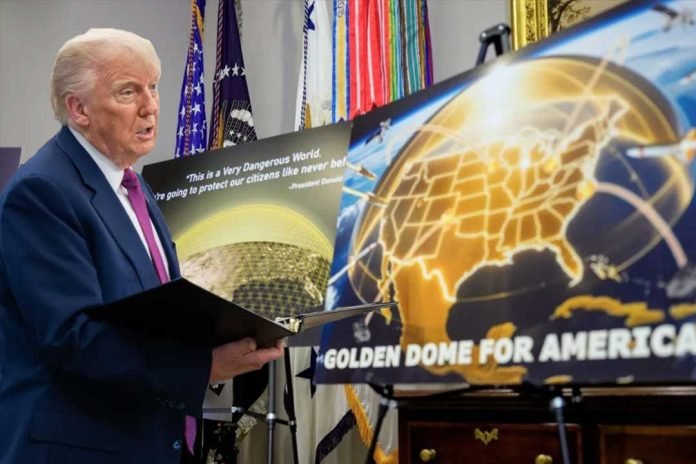The United States is embarking on an ambitious and potentially transformative missile defence initiative named the ‘Golden Dome for America’. Proposed by President Donald Trump and currently being pursued by his administration, this project aims to create a multi-layered shield to protect the US mainland from a full spectrum of aerial threats, including ballistic, hypersonic, and cruise missiles, as well as drones, launched from anywhere in the world, including space.
Origins and Inspiration
The concept of the Golden Dome first gained public attention during Trump’s joint address to Congress in March 2024, where he called for significant funding for the project. While it draws inspiration from Israel’s highly successful ‘Iron Dome’ system, which primarily counters short-range rockets, the Golden Dome is envisioned on a far grander and more technologically advanced scale. It also echoes Ronald Reagan’s ‘Strategic Defence Initiative’ (SDI), often dubbed ‘Star Wars’, from the 1980s, which aimed to use space-based systems to intercept nuclear missiles.
President Donald Trump has expressed confidence that the Golden Dome system could be ‘fully operational’ within two-and-a-half to three years, an aggressive timeline many experts view as highly optimistic. Republican lawmakers have proposed an initial funding of $25 billion, though its approval is tied to a larger, contentious defence package in Congress
Key Features and Architecture
The Golden Dome is designed as a ‘system of systems’, integrating existing ground-based defences with cutting-edge space-based capabilities. Its proposed architecture includes:
Space-Based Sensors and Interceptors: Thousands of orbiting satellites would carry advanced sensors to detect missile launches in real-time and deploy interceptors to neutralise threats in their earliest stages of flight (boost phase) or mid-course. This is a critical departure from current systems, as it aims to destroy missiles before they can deploy countermeasures or manoeuvre.
Multi-Layered Defence: The system would operate across land, sea, and space, offering multiple opportunities to detect and destroy incoming missiles. This includes ground-based interceptors (GBIs) for ICBMs and air-based defences for cruise missiles and drones.
Next-Generation Technologies: The project emphasises the deployment of advanced technologies, potentially including laser weapons and non-kinetic capabilities, to augment kinetic interception.
Domain Awareness Layer: A crucial component involves enhanced domain awareness to track threats comprehensively across all altitudes and speeds.
General Michael Guetlein of the US Space Force has been named to oversee the project’s development and implementation.
Cost and Timeline
The estimated cost of the Golden Dome project is substantial, with initial projections of around $175 billion. However, some analyses suggest that full-scale deployment over two decades could push the total cost closer to $1 trillion, making it one of the most expensive defence projects in the history of the United States. President Trump has expressed confidence that the system could be ‘fully operational’ within two-and-a-half to three years, an aggressive timeline many experts view as highly optimistic. Republican lawmakers have proposed an initial funding of $25 billion, though its approval is tied to a larger, contentious defence package in Congress.
In contrast to Israel’s Iron Dome, the Golden Dome is envisioned as a nationwide, multi-layered shield against a much broader and more advanced spectrum of threats, including ICBMs, hypersonic glide vehicles, and weapons launched from space. Its core innovation lies in its reliance on space-based assets, a significant departure from the Iron Dome’s purely terrestrial architecture
Challenges and Controversies
The Golden Dome project faces numerous significant challenges and has generated considerable debate:
Technical Feasibility: Experts question the technical feasibility of intercepting advanced missiles, especially hypersonic glide vehicles, and ICBMs in their boost phase, at the scale envisioned. The sheer number of orbiting weapons and the precision required are unprecedented.
Astronomical Cost: The projected costs are a major concern, potentially diverting vast resources from other critical defence and domestic programmes.
Geopolitical Implications and Arms Race: China and Russia have vehemently criticised the Golden Dome, calling it ‘deeply destabilising’ and expressing concerns that it could turn space into ‘an arena for armed confrontation’. Critics warn that the project could ignite a new arms race in space, prompting adversaries to expand their missile arsenals and develop anti-satellite capabilities to counter the US system.
Space Debris: Deploying thousands of new satellites and interceptors in low Earth orbit significantly increases the risk of collisions and the generation of space debris, potentially making certain orbits unusable for years.
International Cooperation: The success of a comprehensive North American shield, particularly against threats from across the North Pole, relies heavily on cooperation with Canada, which has shown hesitation despite ongoing NORAD upgrades.
Deterrence Concerns: Some argue that a comprehensive missile shield could undermine the concept of nuclear deterrence, where the threat of mutually assured destruction prevents first strikes.
Golden Dome Vs Iron Dome
The United States’ proposed ‘Golden Dome’ missile defence system, while drawing its very name and initial inspiration from Israel’s highly successful ‘Iron Dome’, represents a fundamentally different and vastly more ambitious undertaking. Israel’s Iron Dome is a battle-tested, ground-based air defence system primarily designed to intercept short-range rockets, artillery shells, and drones, protecting specific, relatively confined urban areas within its borders. Its effectiveness stems from a sophisticated radar system that rapidly identifies incoming projectiles, calculates their trajectories, and launches interceptor missiles only if a threat is projected to hit a populated area, thus conserving expensive interceptors. This localised, ground-to-air approach has proven remarkably successful in mitigating threats from neighbouring territories.
The Golden Dome project faces numerous significant challenges and has generated considerable debate. Experts question the technical feasibility of intercepting advanced missiles, especially hypersonic glide vehicles, and ICBMs in their boost phase, at the scale envisioned. The sheer number of orbiting weapons and the precision required are unprecedented.
In stark contrast, the US Golden Dome is envisioned as a nationwide, multi-layered shield against a far broader and more advanced spectrum of threats, including intercontinental ballistic missiles (ICBMs), hypersonic glide vehicles, advanced cruise missiles, and even weapons launched from space. Its core innovation lies in its heavy reliance on space-based assets, a significant departure from the Iron Dome’s purely terrestrial architecture. The Golden Dome proposes deploying thousands of orbiting satellites equipped with advanced sensors to detect missile launches globally, ideally intercepting them in their vulnerable ‘boost phase’ shortly after liftoff, or mid-course. This unprecedented scale aims to provide comprehensive protection across the vast US landmass; a challenge orders of magnitude greater than defending Israel’s comparatively smaller territory.
The Iron Dome, while a significant investment, has a proven track record and a manageable operational cost for its intended purpose. The Golden Dome, however, carries an astronomical price tag, with estimates ranging from hundreds of billions to over a trillion dollars, and an aggressive development timeline that many experts deem unrealistic. Furthermore, its space-based component raises profound geopolitical concerns, with critics warning of a potential arms race in outer space and the destabilising effect on global strategic balance.
Outlook
The Golden Dome project represents a bold and ambitious vision for US missile defence, aiming to provide unprecedented protection against evolving aerial threats. While it has strong proponents within the defence industry and some political circles, it faces substantial technical, financial, and geopolitical hurdles. Its ultimate success and impact on global security will depend on overcoming these challenges, securing consistent funding, and navigating complex geopolitical realities in the coming years.
–The writer is Assistant Professor, ICFAI School of Liberal Arts, ICFAI University, Jaipur. The views expressed are of the writer and do not necessarily reflect the views of Raksha Anirveda






